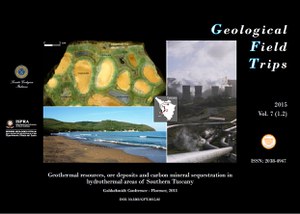Geothermal resources, ore deposits and carbon mineral sequestration in hydrothermal areas of Southern Tuscany
Goldschmidt Conference - Florence, 2013
This three-day geological field trip is focused on different aspects of the Southern Tuscany hydrothermal district, produced by the wide thermal anomaly and magmatism which affected the region in the post-collisional stage of the Apennine orogeny (from Late Miocene to Pleistocene). Past and present hydrothermal activity of southern Tuscany is of great importance from many historical, economic and scientific points of view as it produced numerous ore deposits, some of which were exploited for their metal contents since the late Chalcolithic, and it was also responsible for carbonation of serpentinites, that is a good example of natural carbon dioxide sequestration. Present-day hydrothermal activity supplies the hot steam exploited in the Larderello-Travale and Mt. Amiata areas, one of the most important geothermal districts of the world.
The excursion includes a visit to the Larderello geothermal field, as well as to some relevant ore deposits (the Cu-Pb-Zn-Ag skarn deposit of Temperino, Campiglia Marittima; the Cu mine of Pavone, Montecastelli), and to spectacular natural examples of carbon dioxide sequestration (magnesite mine of Malentrata; surface deposits of hydrated Mg-carbonates at Montecastelli). These exquisitely scientific aspects will be accompanied by a visit to historical and archaeological emergencies of great importance (the medieval towns of Rocca S. Silvestro and Massa Marittima; the Etruscan necropolis of Baratti-Populonia).
DOI 10.3301/GFT.2015.02

